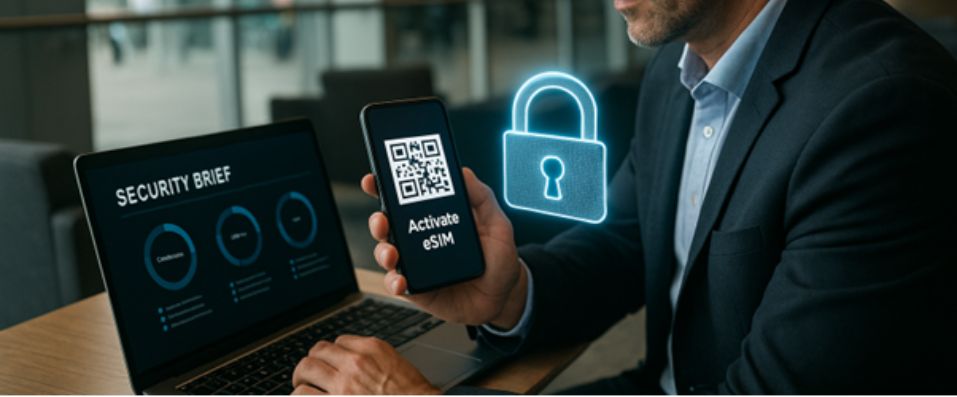Secure-by-Default Travel: A 2025 U.S. Security Brief on eSIM
September 22, 2025 • César Daniel Barreto

Airports are bright, busy, and blind to your threat model. Between a red-eye and a boardroom, the weakest link isn’t always your MDM baseline—it’s the shaky Wi-Fi, the QR code you scanned in a hurry, or the SMS code that never should’ve been your second factor.
This brief translates security engineering into travel-day moves, with a clear-eyed look at what eSIM changes (and what it doesn’t). Threat Model, Provisioning Risks, and Field-Proof Mobile Hygiene for Executives & Analysts
eSIM in one page (no acronym soup)
eSIM shifts you from swapping plastic to remotely provisioning a cellular profile onto a secure element (the eUICC) already embedded in your phone. A server (SM-DP+) delivers the profile, and your device’s local agent (LPA) installs and activates it. Practically, it means:
- No kiosks or street vendors for “tourist SIMs.”
- Multiple profiles on one device (corporate, travel, regional).
- Fast failover if a number or data plan is compromised.
If you need a plain-language primer on the moving parts before you brief the team, see Holafly’s website.
What eSIM changes in your threat model
Reduces
- Physical SIM-swap exposure: No more handing over passports or standing at kiosks where shoulder-surfing is a sport.
- Loss/theft blast radius: Remotely revoke a profile; no plastic to clone from the tray.
Does not eliminate
- Device compromise risk: If the handset is owned, the SIM profile’s integrity doesn’t save exfiltrated data.
- Legacy network exposure: SS7/SIGTRAN routing issues and stingray/IMSI-catcher realities remain environmental hazards.
- Human error: QR codes in email chains, activation on hostile Wi-Fi, sloppy 2FA that routes through SMS.
Adds (new) considerations
- Provisioning integrity: You’re trusting a supply chain (issuer domain, certificate pinning, app agent).
- Profile lifecycle: More profiles = more hygiene (naming, locking, deleting).
Provisioning risks & the hardening playbook
Risk 1: QR-phish and fake issuers
- Mitigation: Verify issuer domain out-of-band; prefer links delivered via your MDM or a known vendor portal. Treat QR images as one-time secrets: store in a secure files app, delete after activation.
Risk 2: Captive-portal activation
- Mitigation: Activate over a trusted network (home/office) with per-app VPN enabled and private DNS. If you must use hotel Wi-Fi, put the laptop/phone behind your own hotspot first.
Risk 3: Profile sprawl
- Mitigation: Name profiles clearly (e.g., “Corp-US”, “Trip-EMEA-2025-Q2”), lock the active travel profile, and delete expired ones at wheels-up back home.
Risk 4: SIM-based OTP reliance
- Mitigation: Migrate to FIDO2/WebAuthn. If SMS must remain as a break-glass path, keep the corp number on the physical SIM and isolate data to the eSIM travel line.
Enterprise controls that travel well
- Baseline via MDM/EMM: Full-disk encryption, OS version floors, hardware-backed key attestation, managed app catalogs, copy/paste guards, jailbreak/root detection.
- Network: Per-app VPN, DNS filtering, TLS inspection exceptions for E2EE apps, cellular preferred over open Wi-Fi.
- Identity: Passkeys at IdP, conditional access (geo, device posture, user risk), short-TTL OAuth tokens, automatic session revocation on SIM profile changes.
- Comms split: eSIM carries data; physical SIM retains voice/SMS for legacy OTP and inbound business calls.
Field playbooks (choose your lane)
Journalists & NGO staff
- Burner profile strategy: New eSIM for each assignment; purge on exit.
- Data diode mindset: Notes/photos to a separate device that never connects to untrusted networks; sync only via your own hotspot.
- Border protocol: Secondary device for travel; power off before checkpoints; minimal data at rest.
Executive protection & analysts
- Risk map by venue: Stadiums, conferences, and legislative buildings = high-probability rogue Wi-Fi and cell interception zones. Prefer cellular data with your own eSIM.
- Team comms: E2EE defaults (Signal/WhatsApp/Matrix) with safety-check features; radio as tertiary.
- Payments & travel apps: Store digital cards in wallet; keep a small cash float. Screenshots of boarding/rail passes in a “Tickets” album for offline.
Roaming vs. airport SIM vs. pocket hotspot vs. preinstalled eSIM
| Option | Security posture | Operational risk | Cost predictability | Best for |
| U.S. carrier roaming pass | Familiar identity; fewer moving parts | Daily fee creep; throttling; noisy logs | Low | Short hops, low-risk travel |
| Airport/vendor SIM | Physical kiosk risk; variable KYC | Line hijack/social engineering at point of sale | Medium | Long single-country stays |
| Pocket hotspot (MiFi) | One shared pipe; device theft risk | Shared creds; battery mgmt | Medium | Teams clustering on one link |
| Preinstalled eSIM (travel line) | No kiosk, strong provisioning path | Profile sprawl if unmanaged | High (prepaid) | Execs, reporters, multi-country trips |
Cold day, hot minute: incident response on the road
- Lost/stolen device: MDM lock + wipe, revoke OAuth refresh tokens at IdP, rotate passkeys where supported, notify carrier to suspend voice/SMS on physical SIM; delete active eSIM profile from the issuer portal.
- Suspected interception: Force cellular only, disable Wi-Fi/Bluetooth, move to E2EE apps, rotate to a fresh eSIM profile, and avoid sensitive actions until posture is re-verified.
- Compromised account signals: Impossible travel alerts, token anomalies—trigger step-up auth, re-enroll passkeys, and quarantine the endpoint in EDR.
Travel-day hygiene (it reads like a packing list)
- Update OS and managed apps 24 hours before departure; reboot.
- Add the travel eSIM at home; label and test; switch data off until landing.
- Per-app VPN on, private DNS set; known SSIDs only.
- Store eSIM QR in a secure files app; delete after activation.
- Switch SMS-based 2FA → passkeys on critical accounts.
- Export emergency contacts, itineraries, and offline maps.
- Carry a 10k mAh power bank; dead phones make bad security decisions.
- Photograph passport/IDs; encrypt copies; keep a paper backup of the first hotel and consulate info.
- Practice the device-loss drill (find-lock-wipe) once—muscle memory matters.
- On return, purge the travel profile, rotate passwords you had to type on the road, and file the after-action notes.
A traveler’s conclusion (with a SOC’s spine)
Secure travel isn’t about paranoia; it’s about removing coin-flip moments. eSIM cuts out kiosks and keeps your corporate number separate from your data line. MDM and passkeys turn theft into an inconvenience instead of an incident.
Per-app VPN and private DNS make hotel Wi-Fi someone else’s problem. Put those pieces together and you trade stress for signal—and keep your attention on the meeting, the interview, or the analysis that actually matters.

César Daniel Barreto
César Daniel Barreto is an esteemed cybersecurity writer and expert, known for his in-depth knowledge and ability to simplify complex cyber security topics. With extensive experience in network security and data protection, he regularly contributes insightful articles and analysis on the latest cybersecurity trends, educating both professionals and the public.